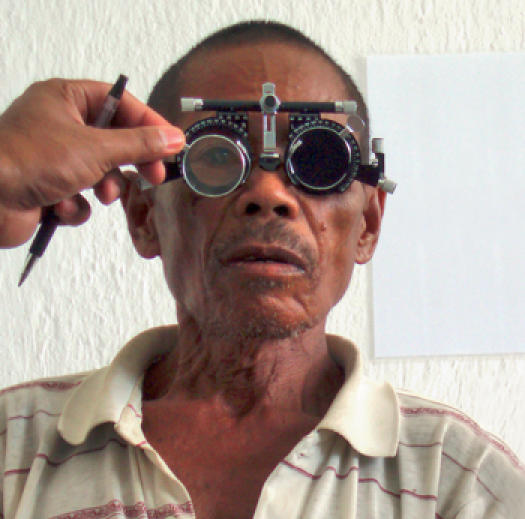Refractive error is a leading cause of low vision in low-resource settings1,2 and its correction is now a priority of VISION 2020. However, spectacles are not included on most essential medicines and supplies lists, and schemes to make them available do not generally receive government support. Additionally, in many countries in the Pacific region, legislation and regulation prohibit the sale of spectacles from public health facilities or by government-employed health workers. This is based on the belief that health services should be provided free of charge. Where spectacles are available from private suppliers, these are mainly in urban areas and are too expensive for most people.
Timor-Leste is one of the poorest countries in the world; 40 per cent of its people live on less than US $0.55/day. There are many barriers to the use of health services, especially for rural inhabitants. As in other countries,3,4 there is a large unmet need for spectacles. An estimated 87,500 Timorese aged ≥40 years need spectacles, but half cannot afford to pay even US $1 for them.5

Performing a refraction. TIMOR-LESTE
Permanent refraction services are available within some government facilities – the referral hospital in Dili, the capital, and four rural eye clinics. In Dili, private optical shops provide spectacles at a price unaffordable to most. Various government and private community health centres offer spectacles, usually donated ‘recycled’ spectacles selected by potential users on a trial and error basis, or handed out by health workers with no training in dispensing. Visiting expatriate teams provide brief, intermittent refraction and dispensing services (mostly ready-made spectacles) in Dili and elsewhere.
To address the identified need for sustainable refraction services and spectacles, Timor-Leste has set up a national spectacle programme as part of its National Eye Health Strategy.6 It aims to provide equitable access to good quality refractive services and affordable spectacles through a financially self-sustaining scheme that uses cross-subsidisation to help those unable to pay.
The programme involves a three-way public-private partnership between: the ministry of health; a local non-governmental organisation, Fo Naroman Timor-Leste; and an international non-governmental development organisation, the Fred Hollows Foundation New Zealand.
Each partner brings particular expertise and makes complementary contributions:
the ministry of health is responsible for regulation: it brings political, regulatory, and staff support capacity (including active participation by ministry of health eye nurses)
the local non-governmental organisation, Fo Naroman Timor-Leste, has an understanding of the social setting and is able to work effectively within the constraints of the country. It is responsible for the implementation of the project: management, service delivery, and supply
the international non-governmental development organisation, the Fred Hollows Foundation New Zealand, supplies ready-made and custom-made spectacles to the government eye clinics. It also undertakes its own refraction and spectacle dispensingactivities. This organisation has experience in systems to address refractive error, quality control, and transparent management, so it provides capacity building and systems development.
All partners have agreed beforehand on activities, stock management, pricing, subsidisation, collection and use of funds, data collection and analysis, reporting requirements, and governance.
Already, despite the civil unrest in Timor-Leste and just 12 months since the partnership commenced, the number of spectacles dispensed has increased by 40 per cent (from 2,050 pairs in 2005/6 to 2,880 in 2006/7), as have the proportion dispensed in rural areas (from 36 per cent in 2005/6 to 45 per cent in 2006/7) and the number dispensed to the poor at subsidised prices (from 12 per cent in 2005/6 to 38 per cent in 2006/7).
The public-private partnership and its excellent working relationships make the Timor-Leste national spectacle programme innovative. Once its cost-effectiveness and adaptability have been assessed, this partnership may be suitable as a template for a sustainable approach to the provision of a complete refraction service in other low-resource settings.
References
- 1.Garap JN, Sheeladevi S, Shamanna B, Nirmalan PK, Brian G, Williams C. Blindness and vision impairment in the elderly of Papua New Guinea. Clin Experiment Ophthalmol. 2006;34:335–41. doi: 10.1111/j.1442-9071.2006.01219.x. [DOI] [PubMed] [Google Scholar]
- 2.Ramke J, Palagyi A, Naduvilath T, du Toit R, Brian G. Prevalence and causes of blindness and low vision in Timor-Leste. Br J Ophthalmol. 2007;91:1117–1121. doi: 10.1136/bjo.2006.106559. [DOI] [PMC free article] [PubMed] [Google Scholar]
- 3.Bourne RR, Dineen BP, Huq DM, Ali SM, Johnson GJ. Correction of refractive error in the adult population of Bangladesh: meeting the unmet need. Invest Ophthalmol Vis Sci. 2004;45:410–7. doi: 10.1167/iovs.03-0129. [DOI] [PubMed] [Google Scholar]
- 4.Fotouhi A, Hashemi H, Raissi B, Mohammad K. Uncorrected refractive errors and spectacle utilisation rate in Tehran: the unmet need. Br J Ophthalmol. 2006;90:534–7. doi: 10.1136/bjo.2005.088344. [DOI] [PMC free article] [PubMed] [Google Scholar]
- 5.Ramke J, du Toit R, Palagyi A, Brian G, Naduvilath T. Correction of refractive error and presbyopia in Timor-Leste. Br J Ophthalmol. 2007;91:860–866. doi: 10.1136/bjo.2006.110502. [DOI] [PMC free article] [PubMed] [Google Scholar]
- 6.Ramke J, Ximenes D, Williams C, du Toit R, Palagyi A, Brian G. An eye health strategy for Timor-Leste: the result of INGDO-Government partnership and a consultative process. Clin Experiment Ophthalmol. 2007;35:394. doi: 10.1111/j.1442-9071.2007.01499.x. [DOI] [PubMed] [Google Scholar]


